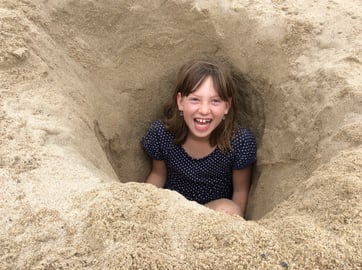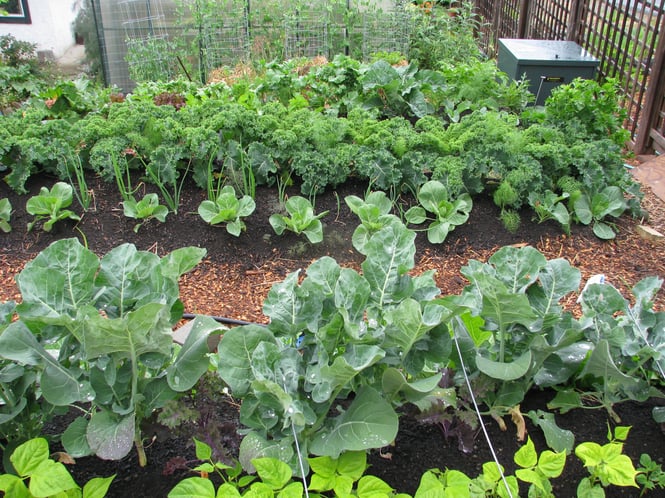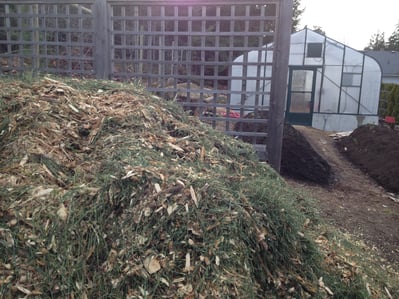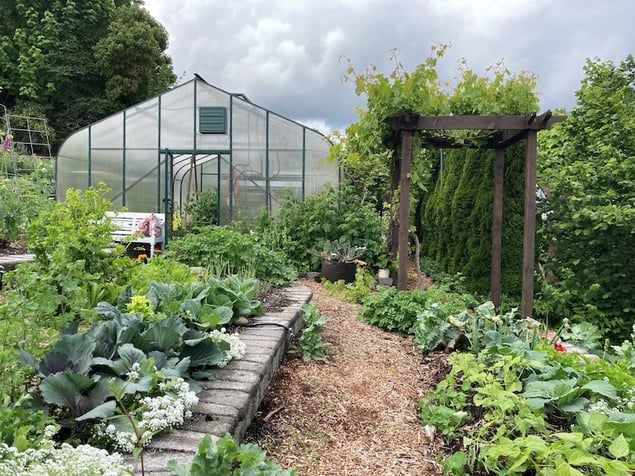Growing Soil with Hügelkultur
When I moved homes and built a new greenhouse, I was in for quite a surprise. The natural soil on my new lot is sand. Pure, yellow sand. This means it drains really well. It also means it does not hold nutrients to feed my plants.
new lot is sand. Pure, yellow sand. This means it drains really well. It also means it does not hold nutrients to feed my plants.
Growing in my new garden is closer to hydroponics than gardening. The nutrients need to be added continuously to make plants grow. So, a few years after I settled in, I decided to grow new soil using a method I found online call Hügelkultur. The bottom line eight years later: hügelkultur saves money, is super easy and my plants are thriving.
What is Hügelkultur?
This is a method of building soil from found materials. Dead trees or logs, scraps of untreated wood, brush laying around your property or found in your neighborhood as all contenders. Unfinished compost, old straw bales and soil in old pots are added to the mix. The materials break down over time to create a spongy layer that holds water and makes your garden more resilient over time.

Who needs Hügelkultur?
Anyone on a plot of land with poor or limited soil will benefit from trying hügelkultur. In my sandy soil, I have just a skim of leaves and duff on top of sandy even though I am several miles from a beach. This is because I live on an island and the soil is poorly developed overall. But my mountaintop cabin also had soil so poor we had trouble growing a lawn and had to continuously add organic matter to get growth of any kind. In my previous city house, only a skim of topsoil was delivered once the contractors were finished the building, so I could have really benefitted from hügelkultur there too. So, whether you live on a newly developed lot with a minimal amount of topsoil or in an area with poor soil to begin with, hügelkultur can improve your soil and garden.
How do you build a Hügelkultur?
The process starts with gathering old rotting and recently chipped organics. I am a regular scavenger in the neighborhood and when I see or hear a tree being cut down, I drop by the site and ask the arborist for the wood chips. This saves them time and money driving to the landfill and paying to dump the waste. It saves me money because I don’t have to buy valuable organic matter. And by the way, I am often asked if it matters what the source of wood is and I say no. Everything works once it is decomposed and chipping starts the decomposition process.
My most recent hügelkultur started with dead trees from the edge of my property. I tossed in a newly dead potted cedar tree that didn’t last the winter, and I added old rotted straw bales from a straw bale garden I had built the year before. I shoved the rescued wood chips into the cracks and crannies between branches and topped it all up with both my finished and still processing compost. Stomping on the whole pile flattens the top a bit helps shape the finished pile which could be as high as four or five feet tall (1.25-1.5 Meters.)
The last step is ordering topsoil from a reliable supplier and adding an inch of soil evenly over the top of the pile. You can plant into your pile immediately or wait until the weather improves for the plants you want. For more information, check out the video I made about building hügelkultur below.
Remember the hügelkultur pile will slowly collapse as the organic matter and brush settles and decomposes. This means my 1.25 meter (4 foot) tall pile collapses within a season to 1 meter (3 feet) and a few years later it is half its original height. I still annually top up the hügelkultur with 2 cm or 1-inch compost each spring.
Where can you build hügelkultur?
Originally my hügelkultur piles were built outdoors as new raised beds. Then I started adding scraped or chips of wood to really large pots and containers and encouraging clients to half-fill their cattle troughs and other large containers with hügelkultur materials. The next frontier is filling greenhouse beds using hügelkultur techniques. If you are trying this, make sure to build the piles above existing beds because they will collapse as they mature.

Results
Plants thrive in my hügelkultur beds and where older soil-only beds quickly start to collapse and become compacted, hügelkultur beds stay open and well-drained for years and after several years, the hügelkultur beds are still growing fantastic plants. I get amazing, powdery mildew-free squash and vegetables where I previously didn’t have any real soil at all.
If you are looking for a way to improve soils quickly and cheaply, especially in your greenhouse beds, I suggest trying hügelkultur this year.
More from Donna
For more great tips from Donna, visit www.donnabalzer.com.
You can also read Donna’s gardening books: No Guff Vegetable Gardening with Steven Biggs and her just-released Gardener’s Gratitude Journal: Part Diary, Part Personal Growing Guide.




